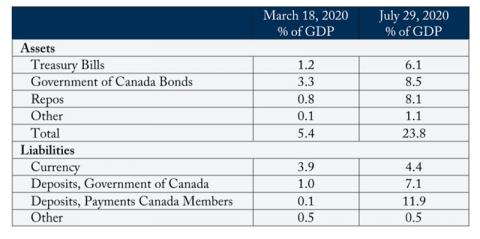From: Stephen Williamson
To: Central bank watchers
Date: August 11, 2020
Re: Three Questions about Bank of Canada Balance Sheet Expansion
Given the unprecedented challenges of a global pandemic, the Bank of Canada has implemented some unconventional policies, with the goal of mitigating the economic effects of COVID-19 and the associated economic constraints.
First, the Bank’s overnight interest rate target has been reduced to 0.25 percent – the effective lower bound, according to the Bank – for an extended period of time. Second, the Bank has greatly expanded the size of its balance sheet. This balance sheet expansion, and some important related questions, are the subject of this memo.
Large central bank balance sheets have become commonplace since the 2008-2009 financial crisis. The Federal Reserve System in the United States, the Bank of Japan, the Bank of England, the European Central Bank, and the Swedish Riksbank, for example, all expanded their balance sheets during the crisis and thereafter, typically through large-scale asset purchases, or quantitative easing (QE), financed by the expansion of interest-bearing reserve balances held by banks. Until March 2020, however, the Bank of Canada had refrained from engaging in QE.
As shown in the chart, as of March, 18, 2020, the Bank of Canada’s assets were 5.4 percent of GDP, and these asset holdings were financed mainly by currency outstanding and deposits of the Government of Canada with the Bank. However, by July 29, Bank of Canada assets had grown sharply to 23.8 percent of GDP. Though this is a very large increase over a short period of time, it brings the Bank of Canada’s assets to a level that is still modest relative to what we see at some other central banks in the world. Central bank assets relative to GDP are currently 36.1 percent in the United States, 54.5 percent in the Euro area, and a whopping 121.8 percent in Japan, for example.
On the asset side of the Bank’s balance sheet, in the table, the Bank has greatly expanded its holdings of Government of Canada securities, as well as its lending – overnight and term – in the market for repurchase agreements (repos). There have been some purchases of provincial government debt, corporate debt, commercial paper, Canada mortgage bonds, and banker’s acceptances, but that was a relatively small part of the expansion.
The increase in assets of course shows up as matching entries on the liabilities side of the Bank’s balance sheet, with an expansion in the interest bearing deposits (reserves) of Payments Canada members with the Bank, a large increase in Government of Canada balances, and a modest increase in currency in circulation.
With this unprecedented expansion of the Bank of Canada’s balance sheet, some key questions come to mind regarding the policy rationale and market phenomena:
- Early in the crisis, the Bank’s asset purchases were intended to improve the functioning of financial markets, and those markets indeed improved. In the July Monetary Policy Report, however, the Bank makes clear that its rationale for QE is now more like the conventional one given by other central banks for conducting QE in a crisis. But, the conventional rationale could be deeply flawed. For example, it is not clear why taking widely traded safe collateral (government debt) out of financial markets, and replacing it with reserves in the banking system, is a good idea. QE may not work, or be detrimental, so why continue with it now in the Canadian context?
- The increase in currency in circulation may appear puzzling, as we might expect that the demand for currency has fallen, due to the decline in economic activity, and because some retailers are not accepting currency. But the increase in currency outstanding is also observed in the United States and the U.K. One potential explanation is that COVID-19 has hampered illegal money laundering, causing cash to pile up outside the financial system.
- Why the large increase in Government of Canada deposits held at the Bank? If QE works, it does so by replacing Government of Canada debt with bank reserves. But, a larger Government of Canada deposit account means that the stock of government debt held by the public must be larger, and reserves smaller. This happens because government debt issuance effectively moves reserves from the banking system to the government’s account with the Bank. This then negates the effects of the Bank’s QE program.
The Bank has a good record of transparency, before and during the current crisis. Providing a deeper explanation for the policy issues in #1 and #3 would be helpful, and would continue that tradition of transparency.
Stephen Williamson is Professor of Economics at Western University, where he holds the Stephen A. Jarislowsky Chair in Central Banking.
To send a comment or leave feedback, email us at blog@cdhowe.org.
The views expressed here are those of the author. The C.D. Howe Institute does not take corporate positions on policy matters.






